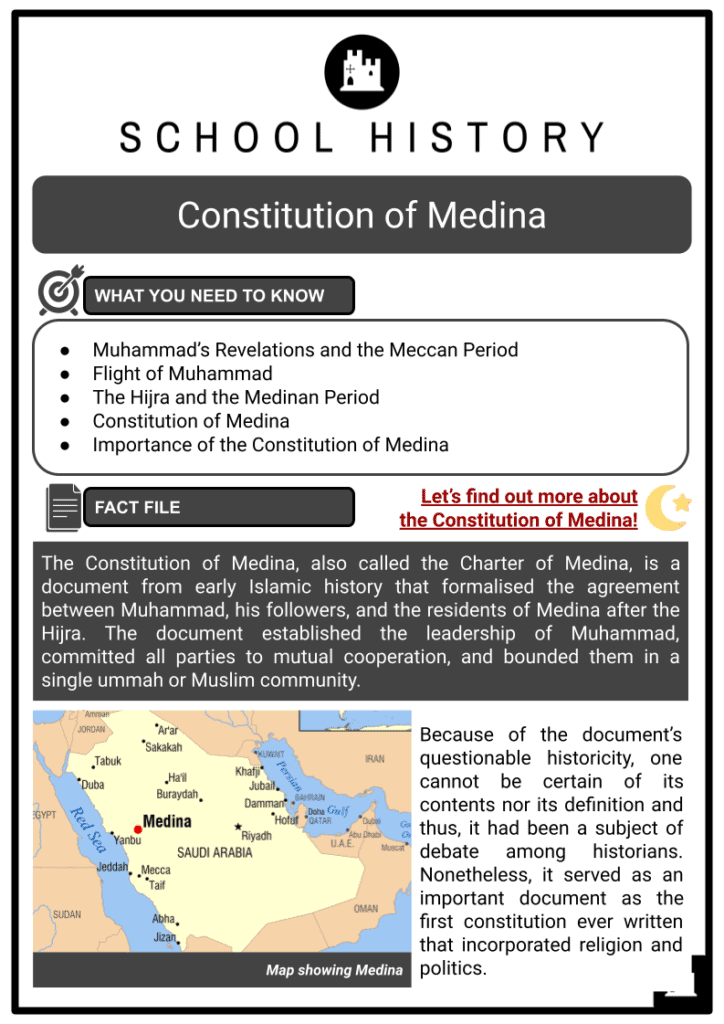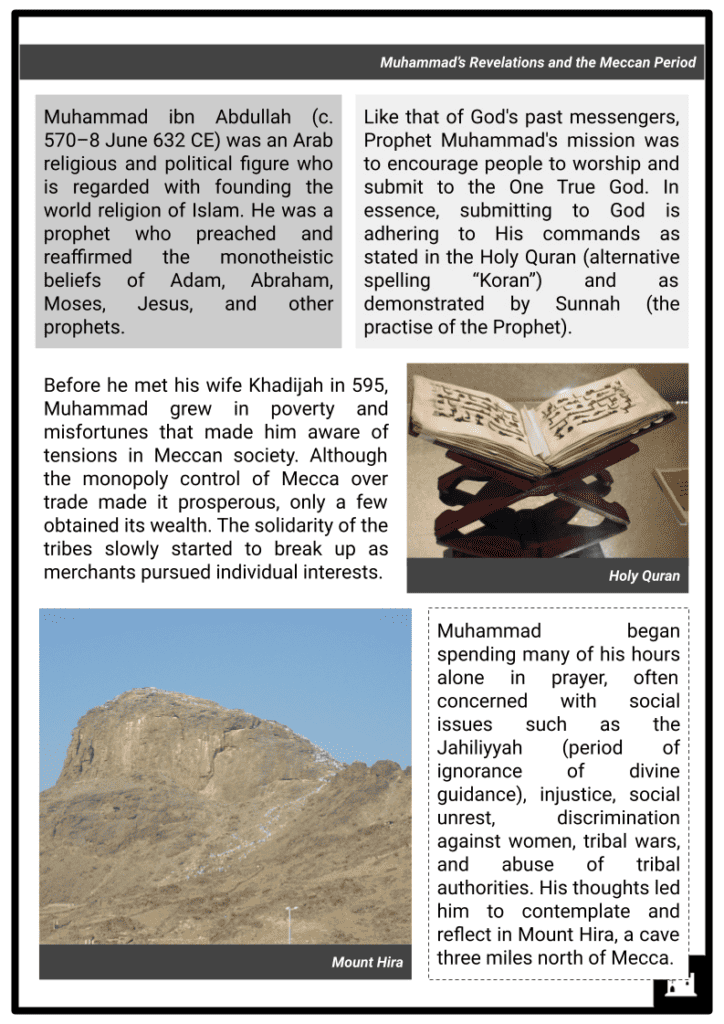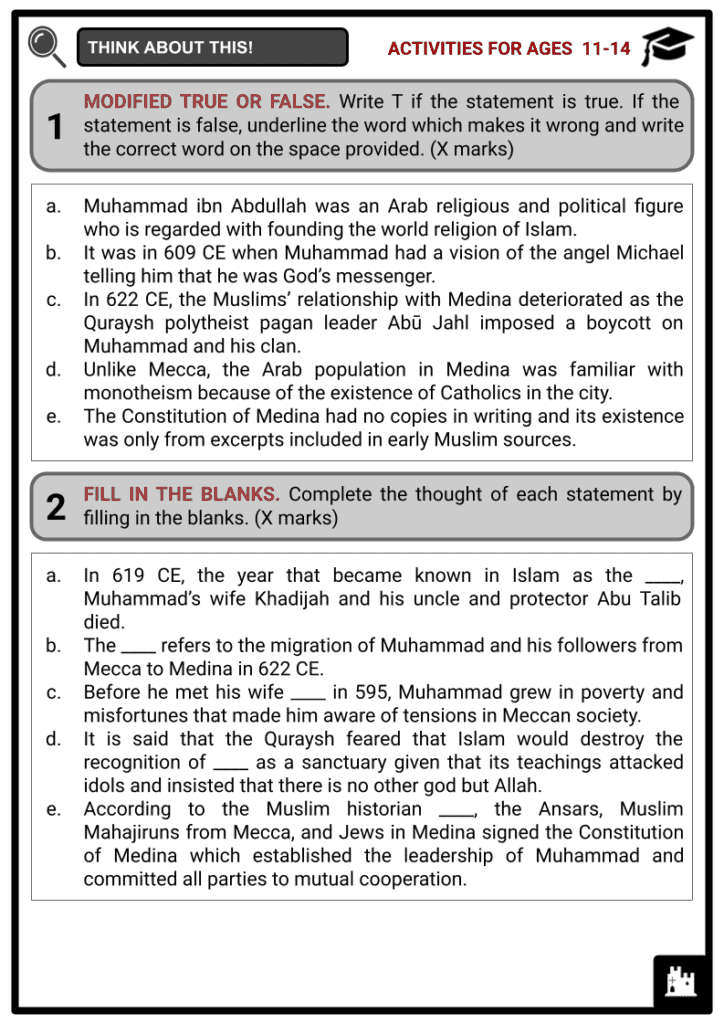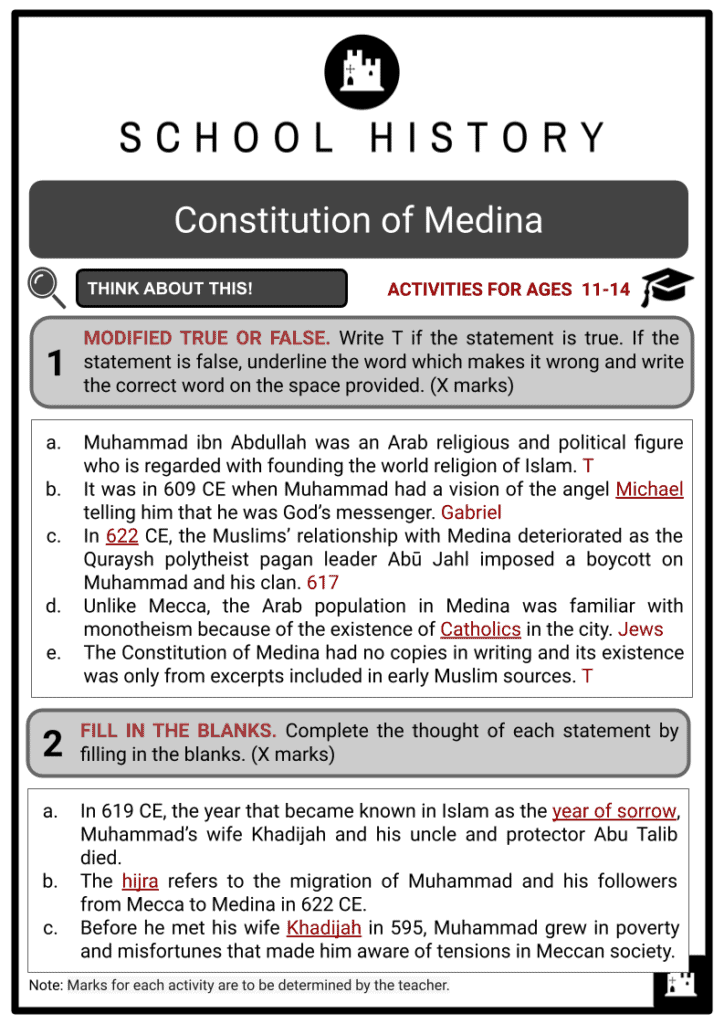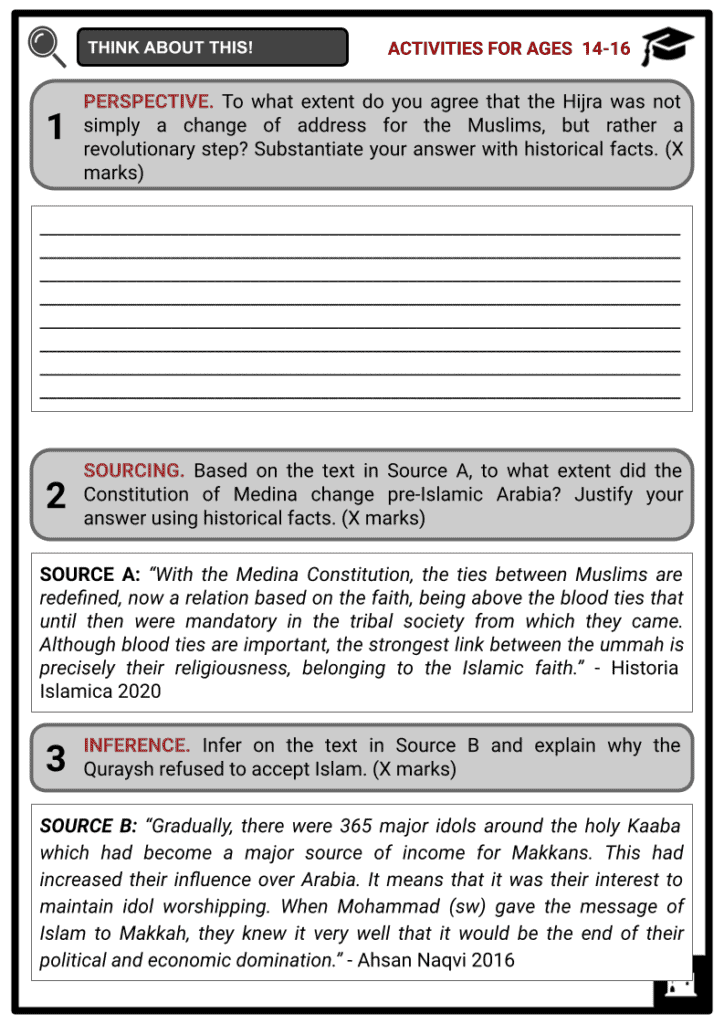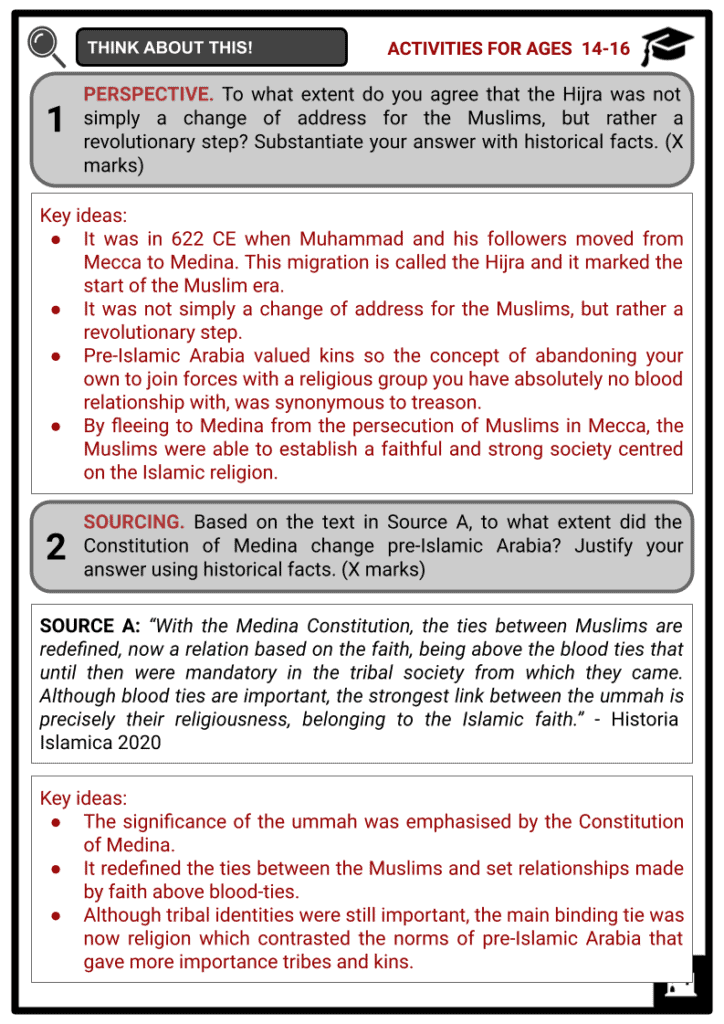Constitution of Medina Worksheets
Do you want to save dozens of hours in time? Get your evenings and weekends back? Be able to teach about the Constitution of Medina to your students?
Our worksheet bundle includes a fact file and printable worksheets and student activities. Perfect for both the classroom and homeschooling!
Summary
- Muhammad’s Revelations and the Meccan Period
- Flight of Muhammad
- The Hijra and the Medinan Period
- Constitution of Medina
- Importance of the Constitution of Medina
Key Facts And Information
Let’s find out more about the Constitution of Medina!
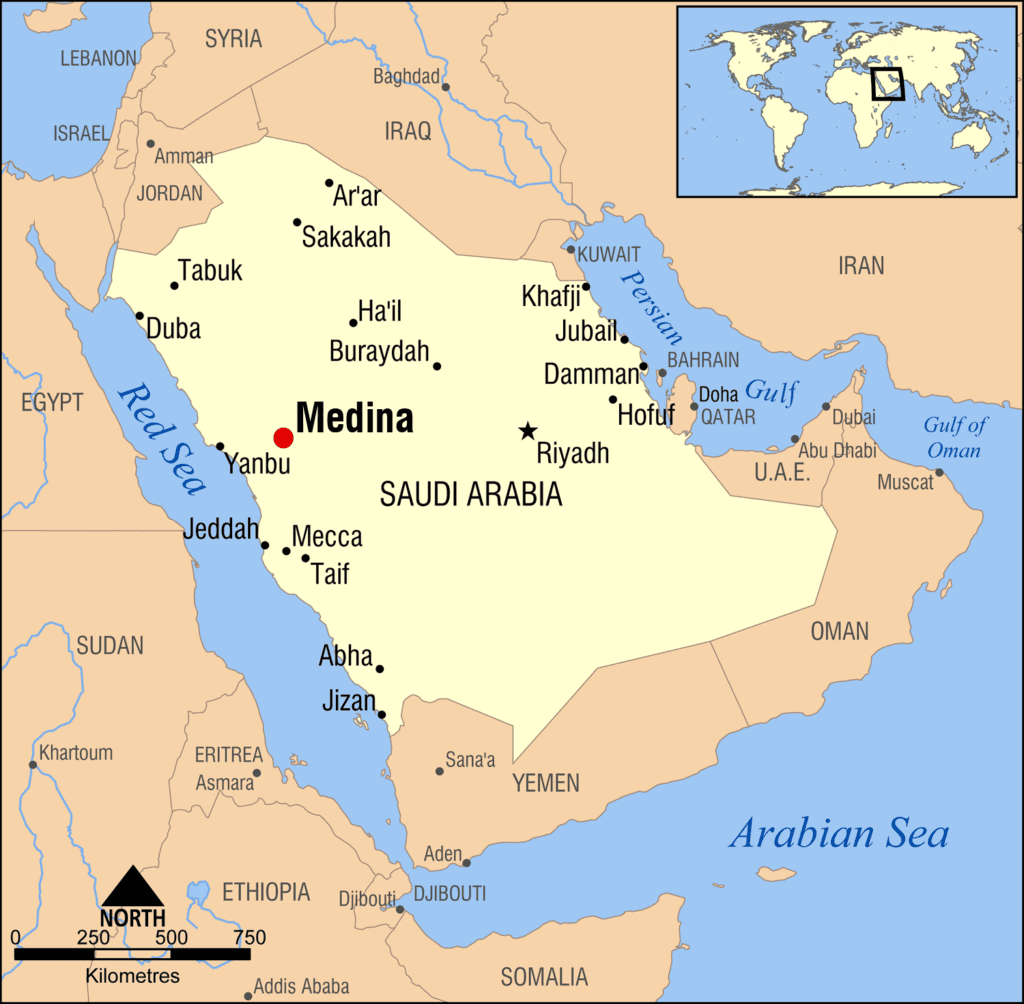
The Constitution of Medina, also called the Charter of Medina, is a document from early Islamic history that formalised the agreement between Muhammad, his followers, and the residents of Medina after the Hijra. The document established the leadership of Muhammad, committed all parties to mutual cooperation, and bounded them in a single ummah or Muslim community. Because of the document’s questionable historicity, one cannot be certain of its contents nor its definition and thus, it had been a subject of debate among historians. Nonetheless, it served as an important document as the first constitution ever written that incorporated religion and politics.
Muhammad’s Revelations and the Meccan Period
- Muhammad ibn Abdullah (c. 570–8 June 632 CE) was an Arab religious and political figure who is regarded with founding the world religion of Islam. He was a prophet who preached and reaffirmed the monotheistic beliefs of Adam, Abraham, Moses, Jesus, and other prophets.
- Like that of God's past messengers, Prophet Muhammad's mission was to encourage people to worship and submit to the One True God. In essence, submitting to God is adhering to His commands as stated in the Holy Quran (alternative spelling “Koran”) and as demonstrated by Sunnah (the practise of the Prophet).
- Before he met his wife Khadijah in 595, Muhammad grew in poverty and misfortunes that made him aware of tensions in Meccan society. Although the monopoly control of Mecca over trade made it prosperous, only a few obtained its wealth. The solidarity of the tribes slowly started to break up as merchants pursued individual interests.
- Muhammad began spending many of his hours alone in prayer, often concerned with social issues such as the Jahiliyyah (period of ignorance of divine guidance), injustice, social unrest, discrimination against women, tribal wars, and abuse of tribal authorities. His thoughts led him to contemplate and reflect in Mount Hira, a cave three miles north of Mecca.
- It was in 609 CE when Muhammad had a vision of the angel Gabriel telling him that he was God’s messenger. From then on till his death, he received “revelations” or verbal messages believed to be from God himself. Although he was deeply distressed by this because of fear that others would dismiss his claims, his wife and his cousin consoled him. This marked the beginning of Muhammad as Prophet.
- Although Mecca at that time was populated by polytheists, Muhammad was able to gain many followers by publicly proclaiming God’s messages, including the emphasis on the goodness of God as reflected in Meccan prosperity. He called on the people to be grateful for God’s generosity and warned that they will appear before Him on the Last Day to be judged for their deeds and assigned to either heaven or hell.
- Aside from his religious preaches, Muhammad also implicitly critiqued the attitudes of rich Meccan merchants, particularly the Quraysh tribe. The latter attempted to bribe him but their efforts were futile as he decisively rejected such offers.
- It is said that the Quraysh feared that Islam would destroy the recognition of Kaaba as a sanctuary given that its teachings attacked idols and insisted that there is no other god but Allah. The Kaaba was important to the Quraysh because it was its polytheistic shrines that they drew their political and religious power from.
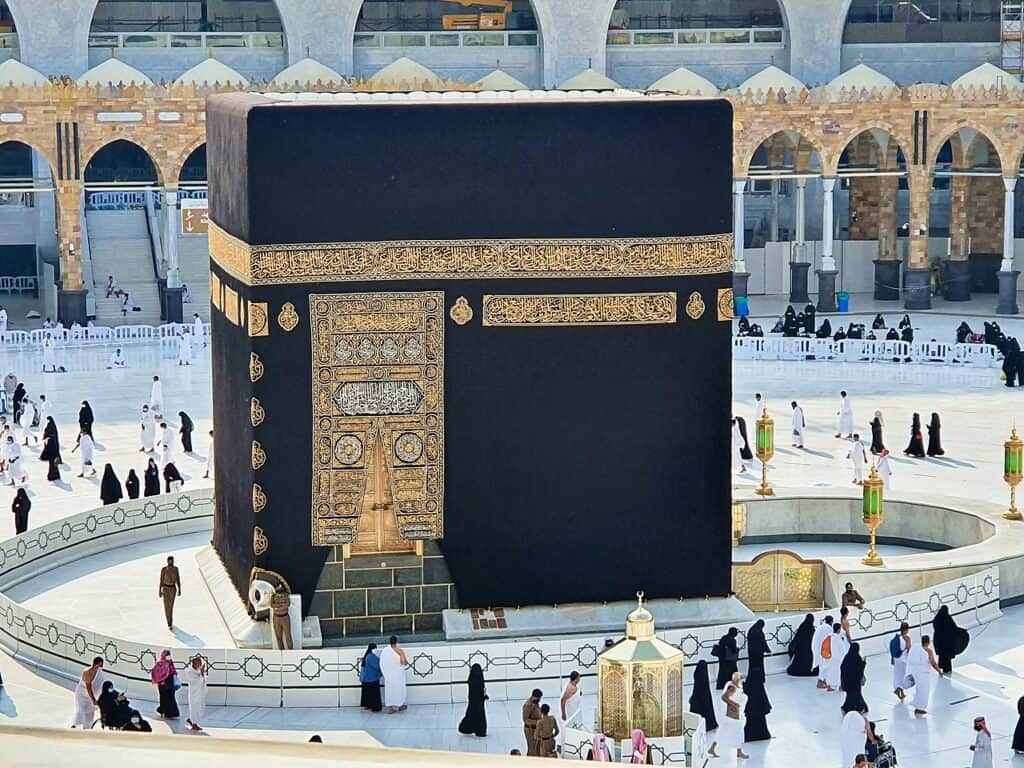
Kaaba - The opposition to Islam in Mecca eventually grew to the persecution of Muslims, leading Muhammad and some of his believers to flee to Medina.
Flight of Muhammad
- In 617, the Muslims’ relationship with Mecca deteriorated as the Quraysh polytheist pagan leader Abū Jahl imposed a boycott on Muhammad and his clan. For two years, the Meccans were banned from marrying and trading with the Muslims. The latter suffered both financially and health-wise due to this.
- In 619 CE, the year that became known in Islam as the “year of sorrow”, Muhammad’s wife Khadijah and his uncle and protector Abu Talib died. When Abu Lahab succeeded Abu Talib as the leader of the Banu Hashim clan, he withdrew the clan’s protection from Muhammad. With no one to protect him and his followers, Muhammad tried to look for a new home.
- After some unsuccessful negotiations, a delegation from Medina invited Muhammad to serve as the chief arbitrator for the entire community. The delegation consisted of representatives from the important clans of the city. They all agreed that tribal conceptions of blood feud no longer work if there was not one single authority to adjudicate. Thus, the members of the delegation pledged to accept Muhammad as the chief arbitrator of the community and protect him as one of their own.
The Hijra and the Medinan Period
- Before the introduction and spread of Islam in Arabia, Medina was already important for its trade and agriculture mainly because of its location in the fertile region of Hejaz. It was dominated by the Jews until Arab tribes gained political power in 400 CE.
- Although many tribes in Medina already abandoned the nomadic lifestyle, the habits of tribal warfare were difficult to remove from their system, making it impossible to live together in peace and harmony. Thus, the people of Medina thought that Muhammad and his teachings would help them live together in a single unified community. Moreover, unlike Mecca, the Arab population in Medina was familiar with monotheism because of the existence of Jews in the city.
- All these favourable conditions in Medina made the spread of Islam in the city faster and easier. The coming of Muhammad and his followers marked the start of the complete religious and political transformation of the city.
- It was in 622 CE when Muhammad and his followers moved from Mecca to Medina. This migration is called the Hijra and it marked the start of the Muslim era. Medina now became home to three very different groups: the Muslims from Mecca, the Pagan Medinan Arabs, and the Jews in Medina.
- For the Muslims, the hijra was not simply a change of address, but rather a revolutionary step. Pre-Islamic Arabia valued kins so the concept of abandoning your own to join forces with a religious group you have absolutely no blood relationship with, was synonymous to treason and this angered the Quraysh more. Thus, they vowed to exterminate the ummah (refers to the Muslim community).
- When they learned of Muhammad’s plans for departure, the Quraysh attempted to assassinate him but failed to do so as he was warned of the plot beforehand. They put a large reward for whoever could find him and bring him back to Mecca.
- Unfortunately, all efforts of the Quraysh failed. After their eight day journey, Muhammad and his believers entered the outskirts of Medina, but did not immediately enter the city. Instead, they stopped by Quba and established a mosque there. After fourteen days of staying in Quba, they finally entered Medina where they were greeted cordially by its people.
- The migration was difficult for the Muslims. In fact, although they were highly aware of the trauma of severance, it wasn’t easy for them to cut ties and depart their tribes. Unlike other emigrants, they were not eager to go forward into a new life in a new city.
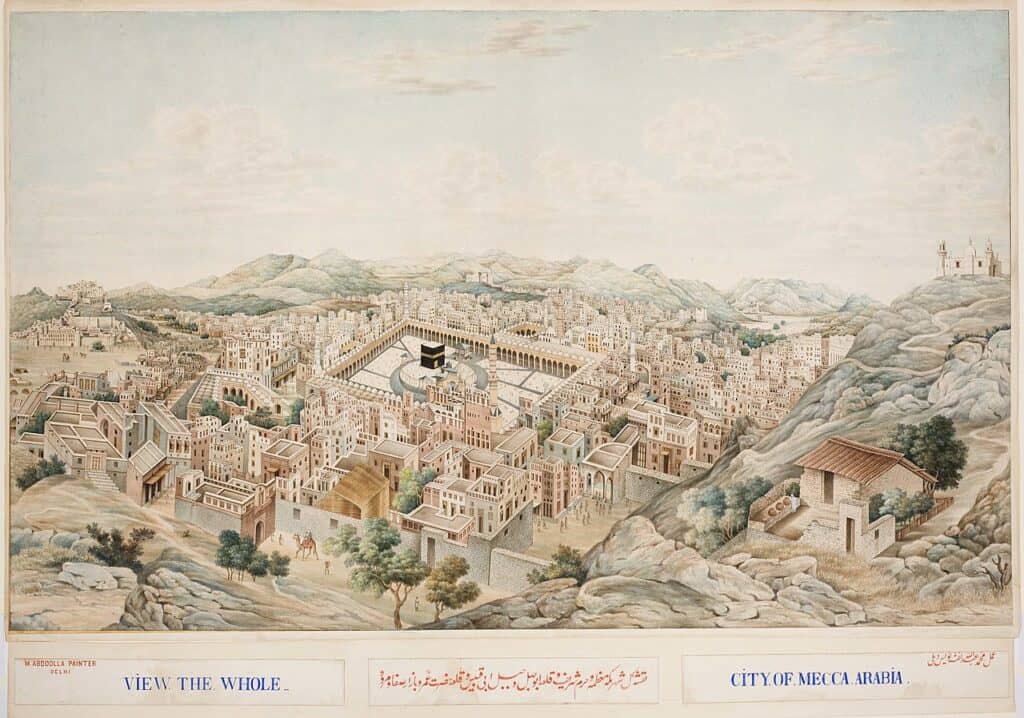
A panorama of Mecca - For Muhammad, a spot in the political office was not something he expected after arriving in the city. In fact, he had no intention of founding a new polity as his objectives were mostly religious. Nonetheless, the circumstances at that time allowed him to accept the responsibility.
Constitution of Medina
- Although nobody in Medina was forced to convert to Islam, Muhammad was able to draw people to the covenant through the Constitution of Medina (also known as the Charter of Medina). The document formalised the agreement between Muhammad, his followers, and the residents of Medina after the hijra.
- According to the Muslim historian Ibn Ishaq, the Ansars (refer to local inhabitants of Medina who took care of the Muslims during the hijra), Muslim Mahajiruns from Mecca (refer to the early Muslims who followed Muhammad), and Jews in Medina signed the constitution which established the leadership of Muhammad and committed all parties to mutual cooperation. All were bound in a single ummah and hence, could not attack each other but rather had to give one another protection.
- The document established amicable dispute-resolution techniques for several ethnic groups coexisting as one people without merging into a single religion, language, or culture. This fully demonstrated the great diplomatic skills of Muhammad.
- More importantly, the significance of the ummah was emphasised by the document as it redefined the ties between the Muslims and set relationships made by faith above blood-ties. Although tribal identities were still important, the main binding tie was religion which contrasted the norms of pre-Islamic Arabia.
Key features of the Constitution of Medina
- Creation of the concept of ummah. The Ummah is considered as the most important concept within the document as it represented the new community founded on a belief in one God and the agreement to follow the Prophet Muhammad.
- Redefinition of relationships between Muslims. This ended the pre-Islamic system of the tribe as the most important identity marker.
- Inclusion of Jews in the ummah. Even though the document acknowledged only one distinct religion, which is Islam, the Jews in Medina were still included in one community with the Muslims.
- Rights of non-Muslims. Aside from being in one community, non-Muslims also had certain rights as long as they followed the Muslims. Warfare money for the ummah was expected to be paid by Muslims and non-Muslims alike.
- Complex structure of the Constitution of Medina. Historians have different arguments regarding the structure of the document. Some say that it was split into eight parts, while others say that it was divided into three.
- The Constitution of Medina had no copies in writing, and its existence was only from excerpts included in early Muslim sources such as Ibn Hisham’s “Al-Sīrah Al-Nabawiyyah". Because of its questionable historicity, one cannot be certain of its contents. Nonetheless, many Muslims and Western scholars of Islam believe it existed during Muhammad’s time.
- Although the document was a formalised agreement, some historians like Bernard Lewis, claim that it was not, in the modern sense, a treaty, but a proclamation of Muhammad that gave him a leading role in the community of Medina. On the other hand, L. Ali Khan suggested that the document was a social contract derived from a treaty and built upon the idea of a unified community of diverse tribes coexisting under the rule of a single God.
- Many other historians have come up with different answers regarding what the Constitution of Medina really is. To summarise, the document can be regarded as:
- A Constitution of the State - Represented a set of principles for a political community. However, Medina was not a state.
- A Treaty of the believers and Treaty of the Jews - Takes into account the structure of the Constitution of Medina. However, it overlooks the creation of a new political community that is more than just a treaty.
- A Municipal Charter - Takes into account Medina as a city. However, the term is too Eurocentric to use to explain Arabic culture.
- A Proto -Islamic public law - Honours the similarity of the Constitution of Medina to the Magna Carta. However, Constructs a 'similar' historical story for Arabia as for Europe.
- A Pact of security - Made by comparing 7th century Arabia with contemporary Arabian tribal society and customs. However, it overlooks the creation of a new political community.
Importance of the Constitution of Medina
- The Constitution of Medina is considered to be the first constitution ever written incorporating religion and politics. With many individuals today struggling to resolve inter-religious tensions and conflicts, the Constitution of Medina offers numerous lessons that might be applied to promote religious tolerance in the modern world. It is regarded as a helpful manual for mediating conflicts that are motivated by ideologies of politics, economics, and religion.
- Many of the tenets necessary for a pluralistic community to operate peacefully are outlined in the Constitution of Medina. It has created numerous significant principles and lessons that are needed today to promote religious tolerance and pluralism.
- Through the Constitution of Medina, the essence of unity, tolerance, love, and respect are drawn upon to create a pluralistic community. Aside from these, security of the community, need to protect one another from threats, discrimination, oppression, and religious freedom are other key lessons that can be drawn from the document alone. Its goal is to create a fully unified population that is at ease and safe around one another.
Image Sources
- https://upload.wikimedia.org/wikipedia/commons/3/31/Medina%2C_Saudi_Arabia_locator_map.png
- https://upload.wikimedia.org/wikipedia/commons/thumb/8/89/The_Ka%27ba%2C_Great_Mosque_of_Mecca%2C_Saudi_Arabia_%284%29.jpg/1280px-The_Ka%27ba%2C_Great_Mosque_of_Mecca%2C_Saudi_Arabia_%284%29.jpg
- https://upload.wikimedia.org/wikipedia/commons/thumb/1/18/Khalili_Collection_Hajj_Mecca_panorama.jpg/1280px-Khalili_Collection_Hajj_Mecca_panorama.jpg

